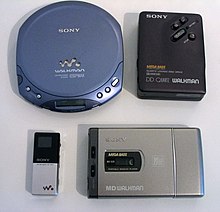The Sony Walkman: An Icon turned Dead Tech
In the age of iPhones, Airpods, Apple Music, and Spotify, it is hard to imagine a time in which music is not immediately available. For $9.99 a month, we can have instant access to millions of songs from thousands of artists with one simple app. From there, technologies like Bluetooth allow us to play these songs anywhere: in our homes, cars, or at the park. We can share the music with large crowds or play it exclusively for ourselves. Before the age of iPhones and other portable music players, there was one device that was disrupting the music industry: the Sony Walkman. The Walkman was unique in the fact that it was the first widely used portable music device, and it allowed individuals to carry their favorite songs around in their pockets. The Walkman is the reason that the music landscape exists in its current form, and it has led to a number of crucial developments, some good (like streaming services), and some bad (like piracy). Regardless, music listening exists in a completely different form today, and the Walkman is the reason why.

The Walkman was born on July 1, 1979 (Haire 2009). The introduction of pre-recorded music cassette tapes in the 1960s ushered in a new era of music portability. However, people still found themselves lugging around bulky cassette recorders to listen to music. So, Sony got the idea for the Walkman: a smaller, sleeker playback-only device that was optimized for headphone use. In the first month, Sony projected about 5,000 sales. However, the Walkman sold upwards of 50,000 units in the first two months. It was an instant hit. The Walkman was not the first portable audio player, but it brought an unprecedented combination of portability, usability, and practicality into one compact, high-quality device. And because of this, the Walkman owned the 1980s. Cassette tapes outsold vinyl for the first time in 1983. In 1986, the word “Walkman” was added to the dictionary. The launch of the aerobic workout craze in the late 1980s made the Walkman an essential workout accessory. Music had never been so accessible and so portable, and the Walkman set a new standard for playback devices (Haire 2009).
In the 1980s, Sony was the first to jump on a massive desire in the market with the Walkman. However, in the 1990s, as technology began to shift away from cassette tapes, they were not as successful. Cassette tapes began to get shelved in favor of CDs and digital MP3 files (Adner 2012), leaving the Walkman outdated in its current form. Sony attempted to pivot with the market, rolling out disc and MP3 players under the Walkman name, but none experienced the same success as the original Walkman (Haire 2009). In the early days of MP3, no product immediately dominated the market, as downloading the files (legally or illegally), was not as simple as purchasing tapes in a traditional retail environment, and the lack of widespread broadband often made these downloads multi-hour affairs. Without all of the pieces in place (a high-quality device, faster internet, and an easily operated music purchasing/management software), a single device was not able to dominate the market. These pieces all fell into place with the launch of the iPod and the iTunes store in the early 2000s, and the iPod took off in a similar manner as the original Walkman, setting a new standard for music playback and laying the foundation for our current landscape of music streaming (Adner 2012).

Throughout the 2000s, Sony, and the rest of the market, took a back seat to the seemingly endless string of hits from Apple. The company simply could not come up with a response for the iPod, and in 2010, they discontinued most editions of the Walkman (Hayden 2010). Within two decades, Sony rose to the top of the portable music player industry, and subsequently lost a market that it, for all intents and purposes, owned. Sony effectively created the portable music player segment and found themselves taking a backseat to Steve Jobs and the iPod (Hayden 2010). Ironically, the iPod most likely would not exist without the Walkman, but as Sony was quick to jump on the market in 1979, in 2001, Apple beat them to it.
Even though the Walkman set the stage for the iPod and current music streaming platforms, it also ushered in a new, unintended trend: music piracy. Even though the peak of music piracy came during the MP3 era with software like Napster, which allowed people to share music files freely over an internet connection (Easley 2005), this trend first evolved alongside the Walkman. In the 1980s, individuals began copying music onto blank cassette tapes (Bottomley 2015). This was uncharted territory, as many record companies and retailers condemned this practice as piracy, however private, non-commercial copying was technically legal (Bottomley 2015). This tape-copying manifested into CD copying, which subsequently turned into MP3 piracy (Bottomley 2015). This new era of piracy has elicited creative responses from record companies and other distributers, which has been partially responsible for the developments of streaming services. Easy, relatively inexpensive streaming services which give individuals access to a wide variety of songs generally discourage piracy, purely due to convenience.
The Walkman had a very successful lifespan. In 1979, the device changed the way we listen to music forever, while also serving as a foundation for devices like the iPod, and services like iTunes and Spotify. Meanwhile, it ushered in an era of song piracy, which was a form of stealing that society had never experienced before. Unfortunately, the Walkman is essentially irrelevant in today’s tech landscape. In the 1980s, I am sure that it was hard to imagine a day where the Walkman was useless, just like it is hard to imagine a world without the iPhone or Spotify today. The Sony Walkman just goes to show that a trademark, revolutionary device is still at risk of being left behind by the ever-changing technology market.
Works Cited
Adner, Ron. “From Walkman to IPod: What Music Tech Teaches Us About Innovation.” The Atlantic, Atlantic Media Company, 5 Mar. 2012, www.theatlantic.com/business/archive/2012/03/from-walkman-to-ipod-what-music-tech-teaches-us-about-innovation/253158/. This article provided a brief summary of the history of the portable music industry. It draws the connections between the Walkman and modern technologies, and coming from the Atlantic, it is reputable.
Bottomley, Andrew. “Home taping is killing music: the recording industries’ 1980s anti-home taping campaigns and struggles over production, labor and creativity.” Creative Industries Journal, 8:2, 123-145, 2015, DOI: 10.1080/17510694.2015.1090223 This article gave a brief history of the beginnings of piracy in the Walkman era. This helped me draw the connections between the Walkman, modern piracy, and streaming services, and being a scholarly article, it is reputable.
Easley, R.F. “Ethical Issues in the Music Industry Response to Innovation and Piracy”. J Bus Ethics 62, 163–168, 2005, https://doi.org/10.1007/s10551-005-0187-3 This article talked about Napster and the development of modern piracy. It also touched on how it has led to services like iTunes and other streaming services and comes from a reputable journal.
Haire, Meaghan. “A Brief History of The Walkman.” Time, Time Inc., 1 July 2009, content.time.com/time/nation/article/0,8599,1907884,00.html. This article gave a history of the life of the Walkman. Coming from Time, it is a reputable article.
Hayden, Erik. “Sony’s Walkman Disappears With a Whimper.” The Atlantic, Atlantic Media Company, 26 Oct. 2013, www.theatlantic.com/technology/archive/2010/10/sony-s-walkman-disappears-with-a-whimper/343691/. This article talks about the demise and the end of the Walkman. Coming from the Atlantic, is it also reputable.